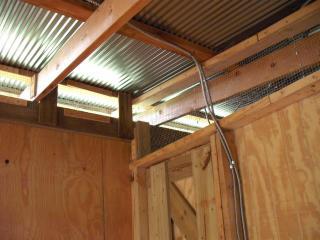I'm a retired civil engineer but my expertise is in large steel welded construction, not wooden trusses and wooden construction. I'd certainly pay a lot of attention to the people who deal with this for a living.
I agree with the mechanical engineers. You'll get better stress flow, less stress concentration, and less deflection if you support the trusses at the ends. That is how trusses are designed.
The design snow load for Faytetteville is 20 pounds per square foot and Joplin's is 30. For these trusses, that is not a lot. Wind load will be more important. I'd feel quite comfortable with 24" centers on the trusses for either wind or snow. I'm not going to analyze it though. I'm not that familiar with the mechanical properties of the wood and would have to make so many assumptions and estimates about your building techniques and actual loads and weights that my numbers would probably not be that valid anyway. You said you are going to make the building 30 feet, so just use all of them. It's more work but there is nothing wrong with building it too strong. You've already got the material.
Most building materials, sheathing, siding, plywood and such, comes in 4 foot widths. When sizing your building, it is good to build in sizes that accommodate this. Remember that you need to look at out-to-out dimensions, not centerline dimensions for some things. It is an easy mistake to make. Not that I've ever done it, but...... Also space your purlins, the studs in the walls. or whatever you are attaching to so you can attach the panelling or whatever you are using without extra trimming. A little forethought or trial fitting before you cut and nail can make life a lot easier.
I'm a little to the south of you. Last May, we had a straight line wind come through that took 36 feet of roof off a 12 foot x 60 foot shed. I'll be defensive and say that I did not build that shed. It was there when I moved here. As a structural engineer, the biggest design problems I had was not the major structural members. Those were easy. The connections were the challenge and that is where the failure here was. The construction was 2x4 purlins on 2 feet centers with a metal roof. The failure was that they used nails too short and smooth to attach the purlins to the rafters. 2-1/2" smooth nails through a 1-1/2" thick purlin does not hold a lot. When I replaced it, it was with 3-1/2" ring-shanked nails. So be serious when you attach your roof to the trusses and your trusses to the building framework. Use those rafter ties geosheets mentioned.
Those diagonal braces Pat mentioned are also a great idea. It helps stop racking which could cause your connectors, whether nails or screws, to work loose. And try not to drop those trusses so you don't loosen the connectors too much.
I built my coop (8'x 12') in the end of this shed. I'll include a shot that maybe shows you how I handled ventilation all around the top. That's hardware cloth over every opening. I've got plenty of overhang outside so rain is not a problem.
Editted for spelling and grammar.





